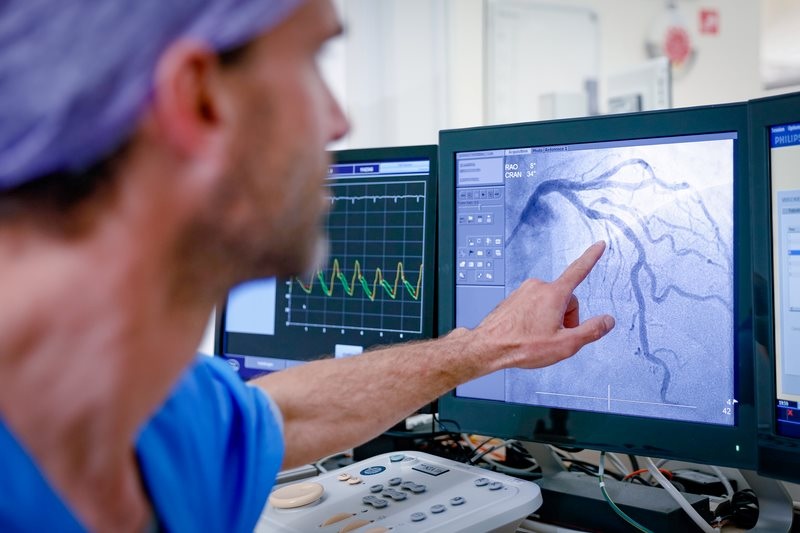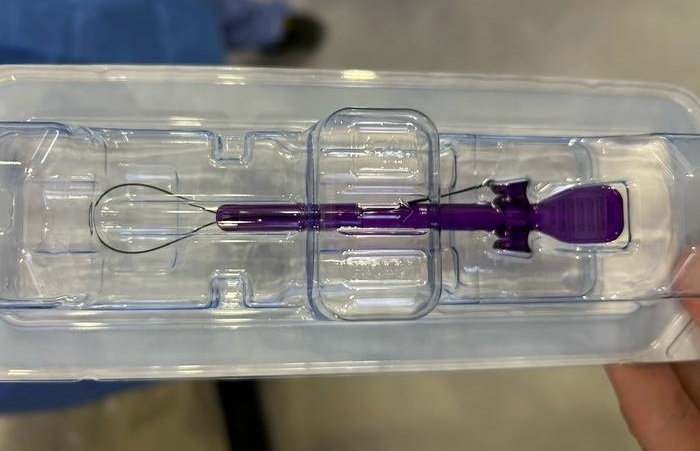Silent Heart Attack Raises Cerebral Infarction Risk
|
By HospiMedica International staff writers Posted on 06 Jun 2019 |
A new study reveals that asymptomatic (silent) heart attacks are associated with double the risk of cardiac embolism and stroke of undetermined cause.
Researchers at Weill Cornell Medical College (New York, NY, USA), the Icelandic Heart Association (IHA; Kopavogur, Iceland), and other institutions conducted a cross-sectional study that included 925 community-dwelling Icelandic individuals (51.9% women, mean age 75.9 years) who underwent both brain magnetic resonance imaging (MRI) and late gadolinium enhanced cardiac MRI to determine whether unrecognized mitral infarction (MI) is associated with cerebral infarction. The main outcomes and measures were unrecognized MI, defined as cardiac MRI evidence of MI without a history of clinical evidence.
The results revealed that 23.9% of participants had cardiac MRI evidence of a heart attack. Of these, 67 experienced MI with symptoms, while 153 had silent heart attack. Overall, 33% had brain MRI evidence of a stroke, and 10% had a stroke of undetermined cause. The researchers calculated that people with symptomatic MI were twice as likely to have a stroke, while those with silent heart attack were 1.5 times as likely to have a stroke. Adjusted for demographics and vascular risk factors, unrecognized MI was also associated with embolic infarcts of undetermined source. The study was published on May 20, 2019, in JAMA Neurology.
“Silent heart attack may be a risk factor for stroke, and may explain some proportion of stroke of undetermined cause; the clot formation that occurs with symptomatic heart attack may also occur with silent heart attack,” said lead study author neurologist Alexander Merkler, MD, of Weill Cornell Medical College. “If further studies confirm these results, doctors may more readily use cardiac MRI in patients with stroke of undetermined cause to see whether there is evidence of silent heart attack. They may also want to compare the effectiveness of anticoagulants to antiplatelet medications such as aspirin, which prevent platelets from clumping together.”
More than 700,000 people a year in the United States alone are diagnosed with a stroke, but in 20-25% of these patients, the cause of stroke cannot be determined. One possible explanation for these strokes is that a distant blood clot travels to the brain following a heart attack. About 50% of all heart attack patients do not experience any symptoms.
Related Links:
Weill Cornell Medical College
Icelandic Heart Association
Researchers at Weill Cornell Medical College (New York, NY, USA), the Icelandic Heart Association (IHA; Kopavogur, Iceland), and other institutions conducted a cross-sectional study that included 925 community-dwelling Icelandic individuals (51.9% women, mean age 75.9 years) who underwent both brain magnetic resonance imaging (MRI) and late gadolinium enhanced cardiac MRI to determine whether unrecognized mitral infarction (MI) is associated with cerebral infarction. The main outcomes and measures were unrecognized MI, defined as cardiac MRI evidence of MI without a history of clinical evidence.
The results revealed that 23.9% of participants had cardiac MRI evidence of a heart attack. Of these, 67 experienced MI with symptoms, while 153 had silent heart attack. Overall, 33% had brain MRI evidence of a stroke, and 10% had a stroke of undetermined cause. The researchers calculated that people with symptomatic MI were twice as likely to have a stroke, while those with silent heart attack were 1.5 times as likely to have a stroke. Adjusted for demographics and vascular risk factors, unrecognized MI was also associated with embolic infarcts of undetermined source. The study was published on May 20, 2019, in JAMA Neurology.
“Silent heart attack may be a risk factor for stroke, and may explain some proportion of stroke of undetermined cause; the clot formation that occurs with symptomatic heart attack may also occur with silent heart attack,” said lead study author neurologist Alexander Merkler, MD, of Weill Cornell Medical College. “If further studies confirm these results, doctors may more readily use cardiac MRI in patients with stroke of undetermined cause to see whether there is evidence of silent heart attack. They may also want to compare the effectiveness of anticoagulants to antiplatelet medications such as aspirin, which prevent platelets from clumping together.”
More than 700,000 people a year in the United States alone are diagnosed with a stroke, but in 20-25% of these patients, the cause of stroke cannot be determined. One possible explanation for these strokes is that a distant blood clot travels to the brain following a heart attack. About 50% of all heart attack patients do not experience any symptoms.
Related Links:
Weill Cornell Medical College
Icelandic Heart Association
Latest Critical Care News
- Miniature Non-Invasive Robotic Catheters to Improve Infertility Treatments
- Stick-On Patch Monitors Baby's Movements In Utero
- EEG-Based AI Technology Accurately Diagnoses Alzheimer’s and Dementia
- Robot Lymphatic System Paves Way for Self-Powered Wearables and Machines
- Focused Ultrasound Technique Successfully Treats Pediatric Brain Cancer
- Nasal Drops Fight Brain Tumors Noninvasively
- AI Helps Optimize Therapy Selection and Dosing for Septic Shock
- Glowing Bacteria ‘Pills’ for Detecting Gut Diseases Could Eliminate Colonoscopies
- Skin-Permeable Polymer Patch Delivers Insulin Non-Invasively Through Skin
- Nanogel Technology Almost 100% Effective in Destroying Drug-Resistant Bacteria Within Hours
- Wearable Ultrasound Sensor Delivers Noninvasive Treatment Without Surgery
- Gel-Free ECG System to Transform Heart Health Diagnosis
- Biodegradable Patch Repairs Damaged Tissue After Heart Attack
- Magnetically Guided Microrobots to Enable Targeted Drug Delivery

- Smart Nanomaterials Detect and Treat Traumatic Brain Injuries Simultaneously
- Earlier Blood Transfusion Could Reduce Heart Failure and Arrhythmia in Heart Disease Patients
Channels
Surgical Techniques
view channelLaparoscopic Surgery Improves Outcomes for Severe Newborn Liver Disease
Biliary atresia is a rare but life-threatening liver condition in newborns that blocks bile flow and leads to progressive liver damage if not treated early. Surgery is typically performed within the first... Read moreNovel Endoscopy Technique Provides Access to Deep Lung Tumors
Detecting lung cancer early can save lives, but diagnosing small tumors deep in the outer regions of the lungs remains a major clinical challenge. Although CT scans frequently identify tiny suspicious... Read morePatient Care
view channel
Revolutionary Automatic IV-Line Flushing Device to Enhance Infusion Care
More than 80% of in-hospital patients receive intravenous (IV) therapy. Every dose of IV medicine delivered in a small volume (<250 mL) infusion bag should be followed by subsequent flushing to ensure... Read more
VR Training Tool Combats Contamination of Portable Medical Equipment
Healthcare-associated infections (HAIs) impact one in every 31 patients, cause nearly 100,000 deaths each year, and cost USD 28.4 billion in direct medical expenses. Notably, up to 75% of these infections... Read more
Portable Biosensor Platform to Reduce Hospital-Acquired Infections
Approximately 4 million patients in the European Union acquire healthcare-associated infections (HAIs) or nosocomial infections each year, with around 37,000 deaths directly resulting from these infections,... Read moreFirst-Of-Its-Kind Portable Germicidal Light Technology Disinfects High-Touch Clinical Surfaces in Seconds
Reducing healthcare-acquired infections (HAIs) remains a pressing issue within global healthcare systems. In the United States alone, 1.7 million patients contract HAIs annually, leading to approximately... Read moreHealth IT
view channel
EMR-Based Tool Predicts Graft Failure After Kidney Transplant
Kidney transplantation offers patients with end-stage kidney disease longer survival and better quality of life than dialysis, yet graft failure remains a major challenge. Although a successful transplant... Read more
Printable Molecule-Selective Nanoparticles Enable Mass Production of Wearable Biosensors
The future of medicine is likely to focus on the personalization of healthcare—understanding exactly what an individual requires and delivering the appropriate combination of nutrients, metabolites, and... Read moreBusiness
view channel
Philips and Masimo Partner to Advance Patient Monitoring Measurement Technologies
Royal Philips (Amsterdam, Netherlands) and Masimo (Irvine, California, USA) have renewed their multi-year strategic collaboration, combining Philips’ expertise in patient monitoring with Masimo’s noninvasive... Read more
B. Braun Acquires Digital Microsurgery Company True Digital Surgery
The high-end microsurgery market in neurosurgery, spine, and ENT is undergoing a significant transformation. Traditional analog microscopes are giving way to digital exoscopes, which provide improved visualization,... Read more
CMEF 2025 to Promote Holistic and High-Quality Development of Medical and Health Industry
The 92nd China International Medical Equipment Fair (CMEF 2025) Autumn Exhibition is scheduled to be held from September 26 to 29 at the China Import and Export Fair Complex (Canton Fair Complex) in Guangzhou.... Read more















